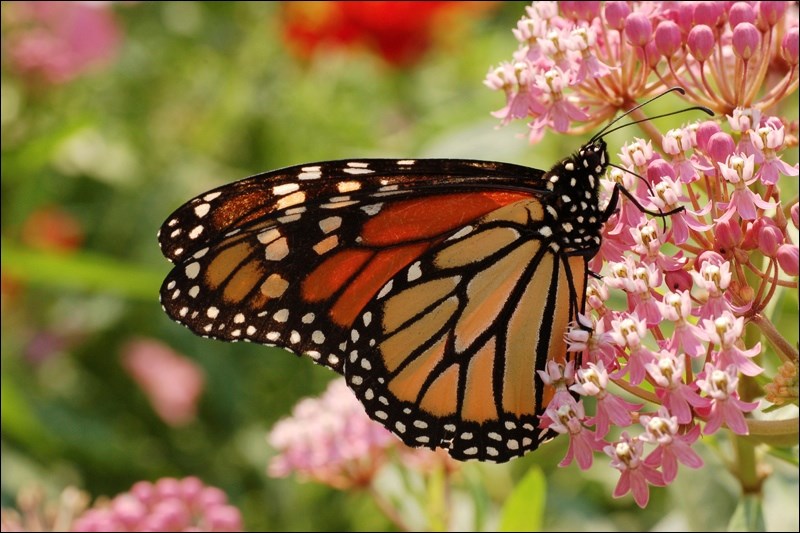A common question I often hear is “how do I attract more butterflies to my yard?”
Butterflies belong to the Lepidoptera order of insects. The caterpillar, or larva, go through a series of ‘instars’ and changes in appearance. Many butterflies spin a silk case or cocoon prior to pupating. This structure is known as a chrysalis. Some butterflies may pupate in crevices or underground. It is important to recognize the larvae as well as the adult forms of the butterfly. Some of the ugliest caterpillars that you might be inclined to kill in your yard may be the immature form of a beautiful butterfly (ex. the spiny elm caterpillar is the immature form of the mourning cloak butterfly). Be sure to identify your caterpillars before assuming they are the bad guys.
In order to attract butterflies, you not only need to attract and feed adult butterflies on nectar rich plants and flowers. You also need to offer them an inviting place to rest, hibernate, lay their eggs and provide food for their larvae and caterpillars to eat.
Butterflies are near sighted and are more attracted to stands of a particular color. Adult butterflies searching for nectar are particularly attracted to red, orange, yellow, purple and pink blossoms, flat-topped flowers and short flower tubes. An area of plants that flower at the same time will be more appealing to butterflies than a lone plant with few flowers.
Plant flowers in sunny places, alongside rocks or stone walls where butterflies can settle. Protecting areas in the garden, specifically using shrubbery, tall grasses or brush piles, will shelter butterflies from the elements and provide a safe place for caterpillars to pupate.
Shallow birdbaths or even a small dish of water in your garden will also be inviting to butterflies. Damp gravel or wet sand will provide a mineral lick for butterflies where they can obtain fluids and minerals.
Nectar-bearing plants are a magnet for adult butterflies. Examples include: milkweed, butterfly weed (Asclepias tuberosa), buddleja (Butterfly bush), echinaceae (Coneflower), lantana, lilac, marigold, ornamental thistles, sunflower, sweet pea, verbena and zinnia.
Plants that will attract butterflies include: penstemon, phlox, salvia, scarlet trumpet, honeysuckle (Lonicera sempervirens), snapdragon, speedwell (Veronica), apiderwort (Tradescantia) and Turk's cap lily (Lilium superbum).
Some of the more common butterflies that you may find on the Prairies, as well as specific plants that will attract these butterflies, are:
• Anise swallowtail (Papilio zelicaon) - sweet fennel, lomatium, citrus
• Black swallowtail (Papilio polyxenes) - parsley, green fennel, dill and rue
• Canadian tiger swallowtail (Papilio canadensis)
• Western tiger swallowtail (Papilio rutulus) - willow, cottonwood, chokecherry
• Yellowpatch or Peck’s skipper (Polites coras, Polites pekius)
• Silver spotted skipper
• Checkered white (Pontia protodice) - mustard family
• Clouded sulfur (Colias philodice) - alfalfa, clover.
• Common checkered skipper - mallow, hollyhock
• Spring azure (Celastrina ladon)
• Summer azure (Celastrina neglecta)
• Grey hairstreak (Strymon melinus): mallow family, hollyhock , rose and marsh mallows
• Monarch (Danaus plexippus) - Milkweed
• Mourning cloak butterfly (Nymphalis antiopa) - willow, aspen, cottonwood, elm
• Variegated fritillary (Euptoieta claudia) - passifloras, pansy
• Milbert’s tortoiseshell - (Nymphalis milberti)
• Red admiral (Vanessa atalanta) - nettle, false nettle, pellitory
• Painted lady (Vanessa cardui) - thistle, hollyhock, sunflower
• Cabbage white butterfly (Pieris rapae)
How many of these butterflies can you attract to your garden!
This column is provided courtesy of the Saskatchewan Perennial Society (SPS; [email protected] ). Check our website (www.saskperennial.ca) or Facebook page (www.facebook.com/saskperennial) for a list of upcoming gardening events: July 7, 9 a.m. and July 10, 6:30 p.m. - Labour and Learn at the Mediation and Rose Gardens at the Forestry Farm; July 8 – self-guided SPS garden tour, start 2 p.m. at 509 - 11th St. East; July 7 to 13 – Hort Week at U of S, Saskatoon, (www.gardening.usask.ca/hortweek).




